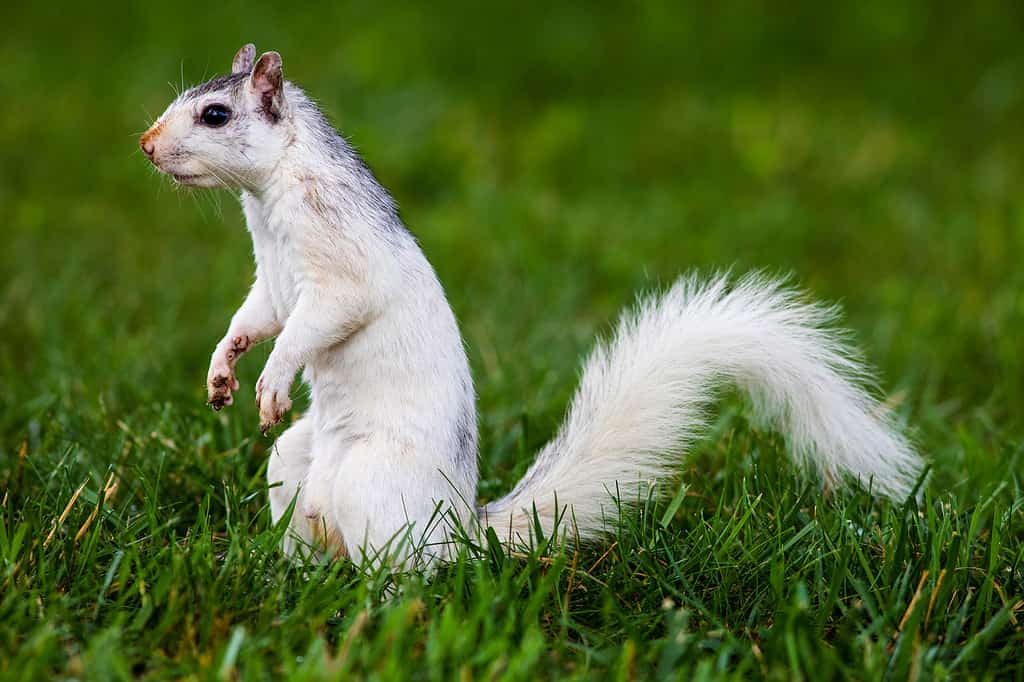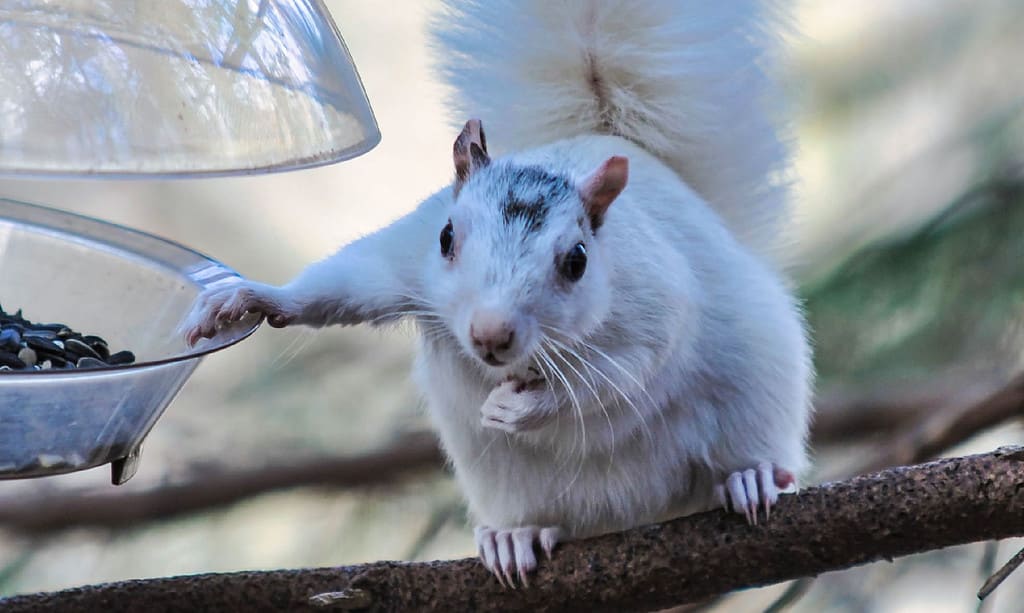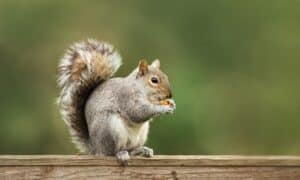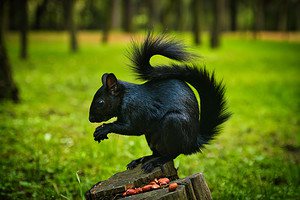If you’ve ever caught a glimpse of a white squirrel, then you can consider yourself lucky. White squirrels are a genetic rarity caused by either albinism or leucism. Although there are over two million Eastern grey squirrels in North America, piebald — also known as pied or leucistic — squirrels make up a small fraction of the total squirrel population. Keep reading to learn all about piebald squirrels, including where you’re most likely to see one.
What Are Piebald Squirrels?
Leucistic squirrels, known as piebald, can be completely white or a dappled mix of white, brown, or grey. They often have dark patches on their heads and backs, although some piebald squirrels can be mostly brown with white spots. Leucistic squirrels are not a separate species but are typically Eastern grey squirrels with reduced pigmentation due to their genetics.
Several different mammals can produce leucistic offspring, including horses, deer, and some types of dogs. Piebald horses are often prized for their distinctive appearances and, thanks to selective breeding, are relatively common. However, less than 2% of deer have piebald coloring, making them similarly rare to piebald squirrels.

These white squirrels are a rare sight outside of a few well-established colonies.
©Sasha Craig/Shutterstock.com
Piebald vs. Albino Squirrels
Piebald squirrels are often mistaken for albino squirrels, but they are not the same. Albinism is a genetic mutation that causes a complete lack of melanin. Albino squirrels typically have pink or blue eyes and are covered entirely by white fur. This genetic mutation is extremely rare, and scientists estimate that the chances of an Eastern Grey Squirrel being albino are around 1 in 100,000.
Piebald squirrels are the result of leucism, which is a genetic mutation that causes reduced pigmentation. These squirrels have mostly white fur, often with some grey streaks on their heads and backs. Piebald squirrels have dark eyes instead of pink eyes.
Are Piebald Squirrels Rare?
Outside of a handful of established colonies in the eastern U.S. and Canada, piebald squirrels are quite rare. In 2015, a wildlife photographer snapped a picture of a piebald fox squirrel in Carrollton, Texas. More recently, residents in Jacksonville, Florida, have reported increasing instances of leucistic squirrel sightings. There are current efforts to document sightings of leucistic squirrels, but it is unclear exactly how many of these unique squirrels exist in the wild.
Where Are Piebald Squirrels Located?
There are several colonies of leucistic squirrels in the eastern United States. One of the largest colonies is located in Brevard, North Carolina, where local experts estimate that 30% of the city’s squirrel population is piebald.
The citizens of Brevard are so fond of their white squirrels that the city council passed an ordinance in 1986 to establish the city as a squirrel sanctuary. Brevard even hosts an annual White Squirrel Festival to celebrate the city’s unofficial animal mascot.
Other colonies of leucistic squirrels are located in Florida, Tennessee, Missouri, and Ontario. However, sightings have occurred recently in Alabama and Texas.

In some areas, piebald squirrels are associated with good luck.
©Terry Maros/Shutterstock.com
Myths and Symbolism of Piebald Squirrels
White squirrels are associated with several different myths and superstitions, especially in the communities where they thrive in large numbers. In Brevard, a leucistic squirrel known as Pisgah Pete was famous for his ability to predict the coming of spring weather as well as which team would win the Super Bowl. In 2022, town officials retired Pisgah Pete and replaced him with Pisgah Penny. Now, Penny has taken over the town’s annual forecasting duties on Feb. 2 — known as White Squirrel Day in Brevard.
In some areas, white squirrels are a sign of good luck. At the University of Texas in Austin, students maintain that spotting a white squirrel on a test day will ensure a passing grade.
White Squirrels in the Wild
White squirrels are in danger in the wild since their fur color makes it difficult for them to hide from predators. While squirrels can adapt to various habitats, they most typically live in and around forested areas. Against a hardwood forest’s brown and green backdrop, white squirrels become easy prey for animals such as hawks, foxes, and weasels.
In addition to wild predators, domestic house cats are a significant threat to white squirrels. Olney, Illinois, has been home to a colony of white squirrels for over 200 years. When their numbers were declining, local officials blamed house cats. However, some experts claim that predators may not recognize white squirrels as prey, making them less likely to be hunted.
The photo featured at the top of this post is © Piotr Kalinowski Photos/Shutterstock.com
Thank you for reading! Have some feedback for us? Contact the AZ Animals editorial team.






